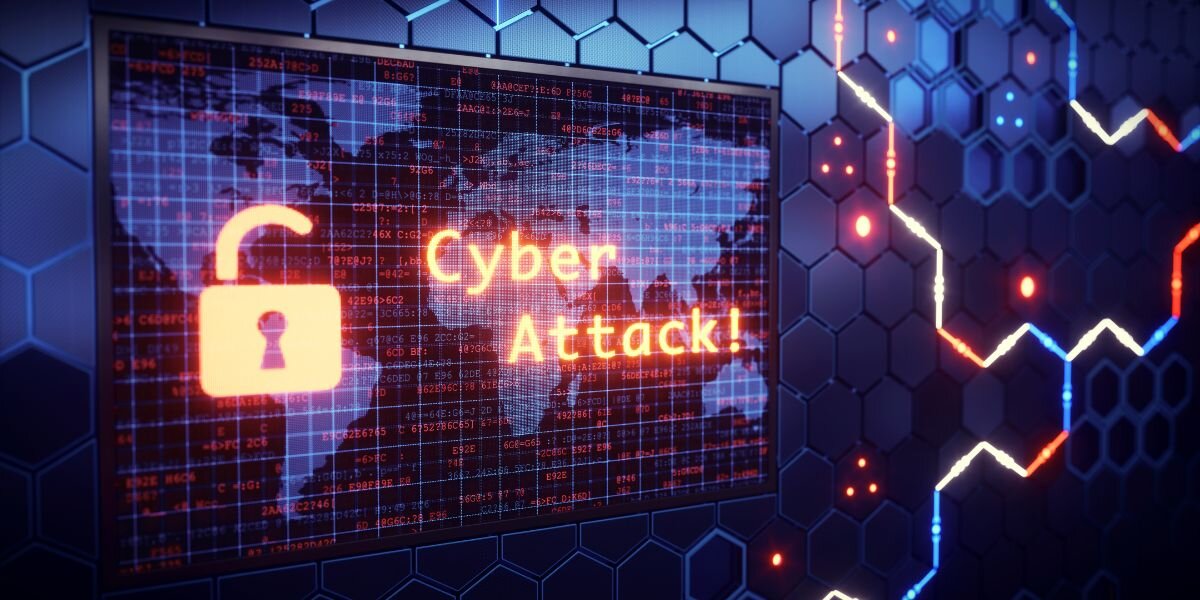Сybersecurity Тhreats: 5 Сtrategies to Mitigate Risks
12.12.2023
In the ever-evolving landscape of digitalization, staying ahead of emerging cybersecurity threats is crucial to safeguarding sensitive data and maintaining the integrity of digital ecosystems. As we approach 2024, several cyber challenges are poised to escalate, demanding a proactive and adaptive approach from companies across various sizes and industries.
In this blog post, we delve into the cybersecurity landscape of 2024, examining the pressing threats on the horizon and exploring proactive measures to fortify your defences.
Critical cybersecurity threats every business must prioritize
The data from this year reveals a staggering reality — a daily detection of approximately 560,000 new instances of malware, coupled with an average of 1248 cyberattacks per week for each organization, as reported by Forbes. These numbers underscore the pervasive and evolving nature of cyber threats that businesses face today. The imminent risks pose not only financial ramifications but also the potential for operational disruptions and reputational harm.
The following are some of the primary cybersecurity risks that require attention:
Ransomware 2.0
Ransomware attacks involve malicious software that encrypts a user's files, rendering them inaccessible until a ransom is paid to the attacker, who then provides the decryption key. These cyber-attacks have been on the rise, and 2024 is expected to witness a surge in sophistication, posing more significant threats to organizations worldwide. Cybercriminals are now employing AI-driven ransomware, capable of adapting and evading traditional security measures. The menace doesn't end with encryption; double extortion tactics, involving the theft of sensitive data before encryption, are becoming more prevalent. This not only adds financial pressure on victims but also amplifies the potential damage to an organization's reputation.

Microsoft reports that 98% of ransom software takes less than four hours to compromise a company's software, with the most malicious variants infiltrating systems in just 45 minutes. The recovery costs from ransom attacks have doubled from 2022 to 2023, emphasizing the need for robust cybersecurity measures and incident response plans.
Distributed Denial of Service Attack (DDoS)
DDoS attacks, a subclass of Denial of Service (DoS) attacks, are among the most common cyber threats. Perpetrators employ botnets (interconnected online devices) to inundate systems, networks, and servers with fake traffic, overwhelming and depleting the victim's resources and bandwidth. Unlike many other cyberattacks, DDoS is not aimed at breaching security but focuses on diverting traffic to make a website inaccessible to legitimate users. In the initial six months of 2023, around 7.9 million DDoS attacks were initiated by cybercriminals, marking a 31% rise compared to the previous year, according to the DDoS Threat Intelligence Report.
The surge can be attributed to ongoing global events such as the Russia-Ukraine war and NATO bids. Indicators of a DDoS attack include:
- Large volumes of traffic from a single IP address.
- Surges in requests to a specific endpoint.
- Unusual traffic patterns at atypical times.
- High traffic from similar profiles in terms of location, browser, device, etc.
To address DDoS attacks, companies need to consider implementing anomaly detection systems to identify unusual patterns in network traffic. This can help detect and respond to attacks in real-time, minimizing the impact on your systems and maintaining service availability.
Man-in-the-middle (MITM) attack
The Man-in-the-Middle Attack (MITM) is another prevalent cyber threat. In this scenario, an attacker intercepts ongoing communication or data exchange between two parties, aiming to eavesdrop on or impersonate one of the participants.
The attack typically occurs in two phases:
- Interception: The attacker intercepts traffic through their network, often by creating an open Wi-Fi hotspot. Users connecting to such networks risk exposing their personal data. Other methods include DNS spoofing, ARP spoofing, and IP spoofing.
- Decryption: After obtaining the victim's data, the attacker decrypts it without alerting the application or user. This can be achieved through SSL hijacking, SSL stripping, SSL BEAST, or HTTPS spoofing.
To counter MITM attacks, companies need robust security practices, protocols, a clear security plan, skilled personnel, and allocated budgets. Individual team members should be vigilant about browser notifications indicating unsecured websites and avoid using unprotected public networks, always connecting through the company VPN.
Info-stealer Malware
An information stealer, often referred to as an "infostealer" or simply a "stealer," is a form of malware, usually in the guise of a Trojan virus, designed to conceal its identity while surreptitiously gathering sensitive information. Its primary objective is to amass data from any computer it infects and execute various attacks, including activities like authentication bypass and session hijacking.
Infostealers pose a significant threat due to their increasing prevalence and accessibility. While they primarily target personal computers through gaming-related channels or illegal account infiltration, corporate devices are also at risk, especially with the "bring your own device" trend and blurred boundaries between professional and personal activities. The ease of deployment, coupled with the risk of compromised corporate accounts through reused passwords, makes infostealers particularly dangerous, as highlighted by the 2023 Verizon Data Breach Investigations Report, which attributes 74% of breaches to human factors like errors, privilege misuse, stolen credentials, or social engineering.
Accedia's cybersecurity practices include safeguarding internet-facing VMs by implementing network security groups (NSGs) to restrict access. NSGs consist of Access Control List (ACL) rules that permit or deny network traffic to a VM from other instances, either within or outside the same subnet. To enhance security, internet access for VMs should be limited, and NSGs should be activated on the subnet, particularly for VMs classified as 'High' severity due to their exposure to the internet.
Cloud malware injection attack
Cloud-based breaches account for 45% of security incidents, with 80% of companies encountering at least one cloud security issue in the past year, and a notable increase of 10%, bringing the figure to 27% for organizations facing public cloud security incidents, as indicated by a recent survey. Cloud malware injection attacks involve hackers inserting malicious apps into a victim's cloud infrastructure to eavesdrop, steal information, or manipulate data.
Common techniques include:
- Cross-site scripting (XSS): Manipulating vulnerable websites to deliver malicious JavaScript code, enabling attackers to access user accounts or deceive users into clicking infected links.
- SQL injection (SQLi): Interfering with SQL queries to access sensitive data, manipulate application behavior, or harm server and backend infrastructure.
Understanding and safeguarding against these cybersecurity threats requires proactive measures, including robust security measures, employee awareness, and continuous monitoring.
What risks do cyber-attacks hold for businesses?
The severity of a cyber-attack can be measured by the impact it has on a business and its various aspects. Here are some of the main implications that weak Cyber Security can cause:
Damaging finances
One of the first effects of cybercrime that comes to mind is always the possible financial damage. Just for reference, according to reports, global cybercrime is expected to cost $10.5 trillion by 2025. This can take many shapes and forms – paying fines, draining the company’s bank accounts, revenue loss, ransomware, drop in sales, decrease in company valuation, and more. And that is just the beginning. Let’s not forget the resources needed for immediate response and recovery, including investigation and analysis. Cybercrime can also affect a company’s revenue indirectly by losing a competitive advantage, customer trust, and operational momentum. Thus, taking the necessary steps to prevent and predict such events and investing in the company’s Cyber Security is always a winning practice.
Risking intellectual property
A company’s intellectual property may include technologies, go-to-market strategies, product design, know-how, trade secrets, competitive advantages, and more. All extremely valuable assets, that if not protected correctly, are vulnerable to cyber-attacks. Still, to this day, the loss of intellectual property is one of the less obvious repercussions of cybercrime. Unfortunately, detecting viruses or malware can take time. According to IBM, the average time to detect a data breach in 2022 is 287 days. Shortening that time as much as possible is crucial as it gives less time for the hacker to either directly use the stolen information or sell it to a competitor. Once the data breach is discovered, the first thing a team needs to do is identify the thieves, recover the data if possible, and block the intruder. This eliminates the risk of further attacks. The second important step is to determine how exactly was the intellectual property stolen and how it can be modified to regain the competitive advantage. Thus, protecting intellectual property requires understanding where its vulnerabilities lie and recognizing the technologies and processes to comprehensively approach potential cyber security threats in the future.
Disrupting operations
Malicious activities can have a detrimental impact not only on the operations of a single company but also on entire economies in some cases. Such examples are the constant cyber-attacks on the Los Angeles port and more specifically on the software of the ships. The attacks halt operations daily due to ransomware, phishing, malware, and credential thefts. As of July 2022, the cyber-attacks over the port of Los Angeles are around 40 million resulting in processes and supply chain blockages.
The disruption of operations can happen in various ways – by erasing or stealing information, infecting systems with malware, or blocking access to systems. The damages may vary depending on the scope of the attack. Moreover, even once normal operations are resumed, IT teams need additional time to determine the root cause, evaluate security vulnerabilities and invest further in Cyber Security practices and technologies.
Damaging the company’s reputation
As Warren Buffet once said: “It takes 20 years to build a reputation and five minutes to ruin it.” Regardless of how satisfied a company’s client base is, it takes a single breach to damage the reputation of an organization. And this goes for customers, vendors, third-party suppliers, and investors. An example is the 2013 breach involving stolen credit card information of over 40 million customers of the US retailer Target. The inevitable loss of trust then resulted in the loss of customers, sales, and a reduction in profits. Losing sensitive data, especially in industries such as healthcare, insurance, or finance, damages the trust of clients and can have a long-lasting impact that some companies never recover from. On one hand, potential clients may view this as negligence and carelessness and would entrust a different company with their personal information. On the other hand, job applicants and employees would rather not associate themselves with a poorly regarded employer.
5 proactive strategies to mitigate cybersecurity threats
In the face of an ever-evolving cyber threat landscape, organizations must adopt proactive measures to safeguard their business reputation and software solutions. This section explores five strategic approaches designed to mitigate cybersecurity threats, providing actionable insights to fortify defences against emerging threats in 2024.
1. Integrating AI for enhanced threat detection and response
Artificial Intelligence (AI) plays a crucial role in augmenting cybersecurity capabilities. Implementing AI-driven solutions can enhance threat detection by analyzing vast datasets in real time, identifying anomalies, and predicting potential risks. Machine learning algorithms enable systems to adapt and learn from emerging threats, providing a dynamic defence against rapidly evolving cyber-attacks.
AI can help organizations detect and respond to threats more quickly than traditional methods, reducing the cost of data breaches by an average of 1.76 million USD. This is based on the findings in IBM's 2023 cybersecurity report.
2. Conducting cybersecurity readiness assessment
Regularly evaluating an organization's cybersecurity posture through assessments is crucial. These assessments, often performed by internal or external cybersecurity teams, help identify vulnerabilities, measure compliance with security standards, and evaluate the effectiveness of existing security measures. By understanding their current security status, organizations can prioritize improvements, allocate resources effectively, and implement targeted strategies to address potential weaknesses. Periodic cybersecurity assessments provide a proactive approach to risk management, allowing organizations to stay ahead of evolving threats and continuously enhance their overall security posture.
3. Penetration testing for software cybersecurity threats
To identify and address potential vulnerabilities in your systems, consider regular penetration testing. This proactive approach involves ethical hackers simulating real-world cyber-attacks to uncover weaknesses in your infrastructure, applications, or network. By conducting thorough penetration tests, you can fortify your defences and patch vulnerabilities before malicious actors exploit them.
As a provider of cybersecurity services, Accedia understands the critical role that penetration testing plays in identifying vulnerabilities and weaknesses in our clients' systems. Through our rigorous and comprehensive testing methodologies, we are able to simulate real-world attacks and provide valuable insights into clients’ security posture. This allows them to proactively address potential threats and protect their sensitive data from malicious actors.
Penetration testing for financial institutions: Download whitepaper
4. Educating and training employees
Employee awareness is a critical line of defense against cyber threats. Regular cybersecurity training programs should be implemented to educate employees about the latest cybersecurity risks and best practices. Training sessions should cover topics such as recognizing phishing attempts, creating strong passwords, and adhering to security policies. Additionally, organizations can conduct simulated phishing exercises to assess employees' ability to identify and avoid phishing attacks. By fostering a cybersecurity-aware culture within the organization, employees become proactive contributors to the overall security strategy, helping to mitigate the risk of human error and insider threats.

5. Finding the right cybersecurity partner
Collaborating with cybersecurity expert companies is an effective strategy to bolster an organization's defences. These external partners bring specialized knowledge and experience, conducting thorough cybersecurity assessments, identifying vulnerabilities, and recommending tailored training programs.
Yet, finding the right partner, especially in areas like cybersecurity, requires a thorough and strategic approach. Among some of the criteria to guide you is:
- Clearly outline your organization's cybersecurity needs and goals to identify specific areas of expertise required from a partner.
- Verify the credentials and certifications of potential partners, such as CISSP or CISM, to ensure expertise and professionalism.
- Look for partners with experience in your industry, as industry-specific knowledge is essential for understanding unique cybersecurity threats and compliance requirements.
- Assess the partner's flexibility and scalability, ensuring they can adapt to changing organizational needs and scale their cybersecurity services accordingly.
Accedia’s internal cyber security practices
We are aware that to provide Cyber Security services and assessments to our clients, Accedia needs to first and foremost be compliant with all industry standards internally. To help the team keep up with the latest news and trends in cyber security we create a monthly Security newsletter. It is distributed throughout the entire company, providing content on data loss prevention, fraud, technology, and cloud security. Here are more of the practices and competencies we have implemented and achieved in that area.

ISO 27001
Evidence of our dedication towards providing the necessary cyber security is Accedia’s compliance with the ISO/ IEC 27001:2013 standard. It’s a guarantee for establishing, implementing, maintaining, and continually improving the Information Security Management within the organization and striving to preserve the integrity and confidentiality of both the company’s and clients’ security. Additionally, the ISO/ IEC 27001:2013 standard helps to improve focus on data security tasks, mitigates damages, increases trust levels, and improves security awareness.
Automotive industry security standard – TISAX
Trusted Information Security Assessment Exchange (TISAX) is an assessment and exchange mechanism for information security in the automotive industry. The TISAX label confirms that a company’s information security management system complies with defined security levels and allows sharing of assessment results across a designated platform. Accedia successfully achieved TISAX certification in 2022.
Microsoft Gold Security Competency
At the beginning of 2022, Accedia obtained the highest level of Security Competency by Microsoft demonstrating our goal to deliver the highest quality solutions to clients looking to protect their data while gaining full control of access management. By working with Microsoft platforms such as Microsoft 365 and Azure, the security competency provides:
- Threat protection
- Identity management
- Information safeguarding
- Security management, and more.
Accedia Cyber Security services
Driven by the goal to provide even better services to our partners, at the beginning of 2022 we started exploring further our Cyber Security capabilities and services. Its main goal is to develop and continuously maintain the needed skills of all security consultants within the company. One of our first success stories is the achieved certification in EC-Council – Ethical Hacker.
Another key part of our security services is driving different initiatives in the Cyber Security area. An example of such initiatives is the Accedia Cyber Security Hackathon, where participants try to “hack” (penetrate) some preconfigured environments and applications.
Last but not least, Accedia has started providing the service Security Vulnerability Assessment. We have already successfully executed several projects helping clients to better secure their applications.
To wrap up
With the exponential digitalization and cloud adoption, cybercriminals are constantly evolving their skills, capabilities, and the intelligence of their attacks. Being mindful of the severity they can have on a business application is crucial. It can help to adopt the right tools and standards and find the right security partner who can provide experience and knowledge into protecting your data.
If you are interested in learning more on the topic of Cyber Security, please don’t hesitate to reach out.
Note: This article is written in collaboration with Yordan Yordanov. Yordan is an Engineering Manager at Accedia with experience in managing projects and clients from various industries and sizes. Apart from his vast knowledge in Microsoft .NET technology stack and Cyber Security, Yordan is a skilled tennis player.